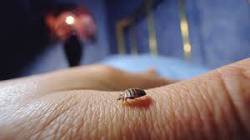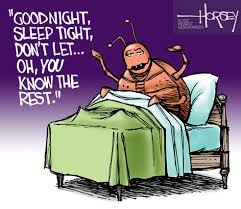
How to Get Rid of Bed Bugs
In the event that you have a bed bug infestation, I suggest you find it early on, before the infestation becomes established or spreads. Treating a minor infestation, while a headache, is significantly less costly and much easier than addressing the same infestation after it is more wide-spread.
However, minimal-degree infestations can also be far more difficult to find and accurately identify. Other pests, such as carpet beetles, can be easily mistaken for bed bugs. In the event you misidentify a bed bug infestation, it offers the insects additional time to spread to other areas of your home or perhaps hitchhike a ride to somebody else’s house to build a brand-new infestation.
What Do Bed bugs look like

A more accurate way to determine a prospective infestation is to look for actual physical signs of bed bugs. Whenever cleaning, switching bedding, or staying away from your home, inspect for:
Red and rusty stains on bed linens or mattresses caused by bed bugs getting smashed.
Dark spots (about this size: •), which are bed bug excrement and may also bleed on the fabric as a marker could.
Eggs and eggshells, which you’ll find are tiny (about 1mm) and pale yellow skins that nymphs shed while they grow bigger.
Bedbugs are small insects that feed on blood from animals or humans. They have six legs, no wings, and a flat, oval-shaped body. They can vary in color from almost white to brown, but they turn rusty red after feeding. They are about the size of an apple seed (5-7 mm or 3/16 – 1/4 inch long) when fully grown. They can be seen by the naked eye, but they often hide in cracks and crevices of beds, furniture, and other objects near where people sleep.
Bed bugs are not a sign of uncleanliness and they do not transmit diseases, but they can cause allergic reactions or skin infections in some people.
The best way to prevent bedbug infestations is to inspect your sleeping areas regularly, avoid bringing used furniture or luggage into your home, and seek professional help if you find any signs of bed bugs.
Where do bed bugs hide?
How Do you Get Bed Bugs
Bed bugs are small, brownish insects that feed on the blood of humans and animals. They can hide in mattresses, furniture, luggage, clothing and other items. They can be brought into your home by traveling, staying in infested hotels or hostels, or receiving used or second-hand items.
Bed bugs can also spread from one apartment to another through cracks in walls, floors and ceilings. Bed bugs are not known to transmit diseases, but they can cause itching, allergic reactions and psychological distress.
If you suspect you have bed bugs, you should inspect your sleeping area carefully, look for signs of bed bugs such as blood stains, fecal spots or shed skins, and contact a professional pest control service to treat the infestation.
When Bed Bugs Bite

Bed bugs are nocturnal insects that feed on the blood of humans and other warm-blooded animals. They usually bite at night, when their hosts are asleep and unaware of their presence.
Bed bugs can bite any exposed area of skin, but they tend to prefer the face, neck, arms and hands. The bites are painless at first, but they can cause itching, swelling and redness later.
Some people may develop allergic reactions or infections from bed bug bites. Bed bugs can also cause psychological distress and insomnia for their victims.
How To Check for Bed Bugs

Here are some steps you can take to check for bed bugs:
Look for physical signs: Bed bugs leave behind physical signs such as small brownish-red stains on sheets, mattress seams or headboard, and fecal spots that look like dark brown or black specks.
Use a flashlight: Bed bugs are nocturnal and hide during the day, so using a flashlight to look for them in crevices and seams of the bed, furniture, and walls can help identify them.
Check for bed bug eggs: Bed bug eggs are tiny, pearly-white, and shaped like a grain of rice. Check seams and folds of bedding and furniture for eggs.
Use bed bug interceptors: Place bed bug interceptors under the legs of the bed to trap and monitor any bed bugs that are trying to climb up onto the bed.
Hire a professional: If you suspect you have bed bugs but are having trouble finding them, consider hiring a pest control professional to inspect your home and treat any infestations.
How to get rid of bed bugs
Bed bugs are small, reddish-brown insects that feed on human blood. They can hide in cracks and crevices of furniture, mattresses, and bedding, and can cause itchy bites and allergic reactions. To get rid of bed bugs, you need to follow a step-by-step process that involves cleaning, vacuuming, steaming, washing, and sealing.
First, you need to identify all the infested areas in your home. Look for live bed bugs, dark spots, reddish stains, and eggs on your mattress, bed frame, box spring, headboard, couch, curtains, and other places where they might hide. You can also use a flashlight and a magnifying glass to inspect these areas more closely.
Second, you need to contain the infestation and prevent it from spreading. Move your bed away from the wall and other furniture, and place bed bug interceptors under the legs of your bed. These are special cups that trap bed bugs when they try to climb up or down your bed. You also need to cover your mattress and box spring with bed bug-proof encasements that zip up tightly and trap the bugs inside. These covers will also protect your bed from future infestations.
Third, you need to eliminate the bed bugs by using various methods. One of the most effective ways is to use heat, as bed bugs cannot survive temperatures above 120°F (49°C). You can wash and dry your bedding, clothing, curtains, and stuffed animals in hot water and high heat for at least 30 minutes. You can also use a steam cleaner to treat your furniture, carpets, and other items that cannot be washed. Move the steam nozzle slowly over the surface, making sure to reach all the cracks and crevices where bed bugs might hide.
Another way to kill bed bugs is to use cold, as they cannot survive temperatures below 0°F (-18°C). You can put small items like books, shoes, and toys in plastic bags and place them in the freezer for at least four days. Make sure the items are not wet or damp before freezing them.
You can also use natural remedies to get rid of bed bugs, such as diatomaceous earth (DE), baking soda, tea tree oil, lavender oil, or neem oil. These substances can dehydrate, suffocate, or repel bed bugs when applied to infested areas. However, they may not be as effective as heat or cold treatments, and they may need to be reapplied frequently.
Fourth, you need to monitor and follow up on your treatment. After you have treated all the infested areas, you need to check them regularly for any signs of bed bug activity. You can also use sticky traps or glue boards to catch any bed bugs that might have escaped or been introduced from outside sources. If you see any live bed bugs or eggs after two weeks of treatment, you may need to repeat the process or call a professional exterminator for help.
Getting rid of bed bugs can be challenging but not impossible. By following these steps and using a combination of methods, you can eliminate these pests from your home and enjoy a peaceful sleep.
Got Bed bugs? contact us
Bed bugs can cause anxiety and inflict bites that can become infected. They spread fast and you don’t want to be the blood meal. Contact Truly Green Pest Control at: 816 377 2811